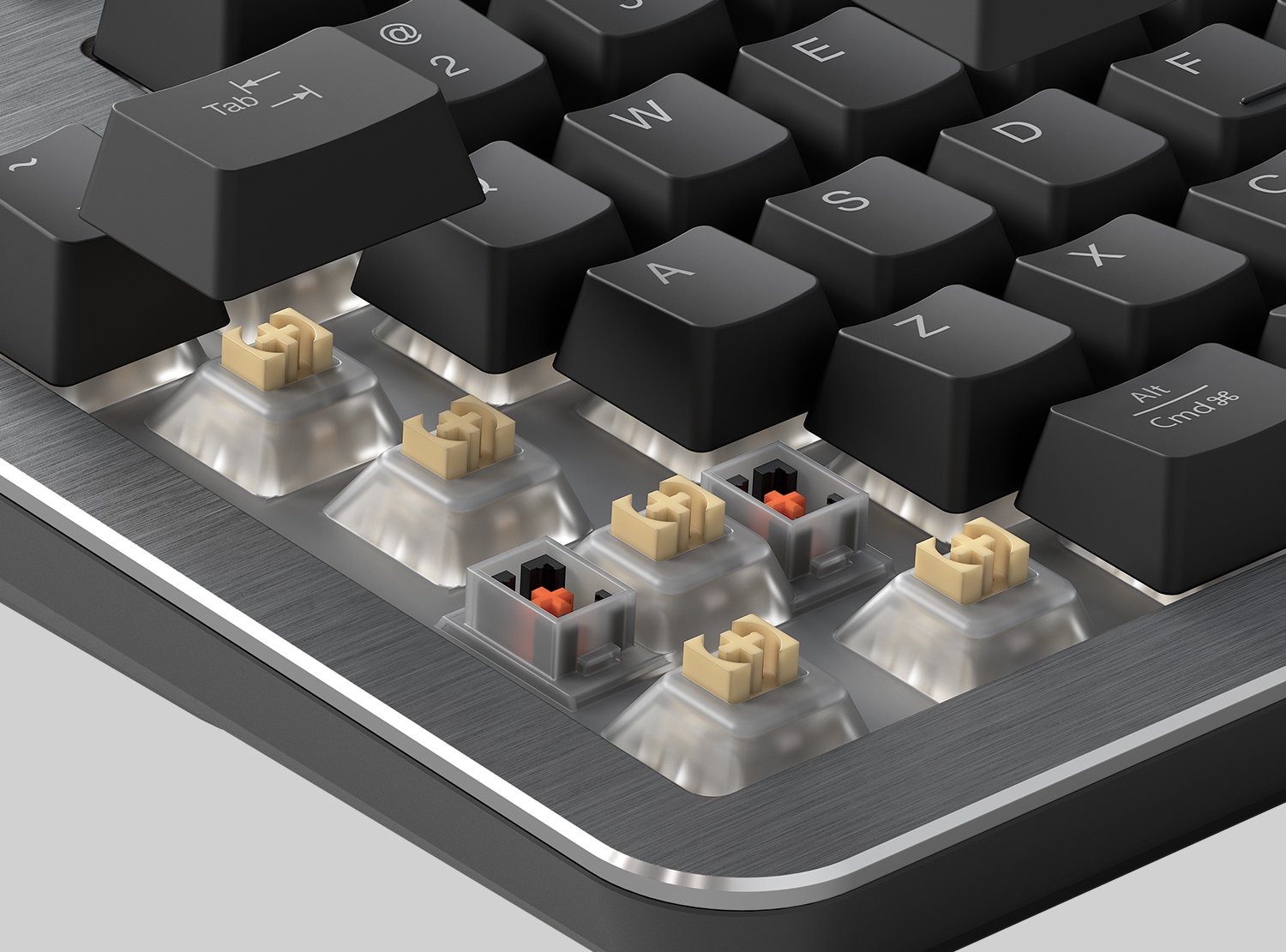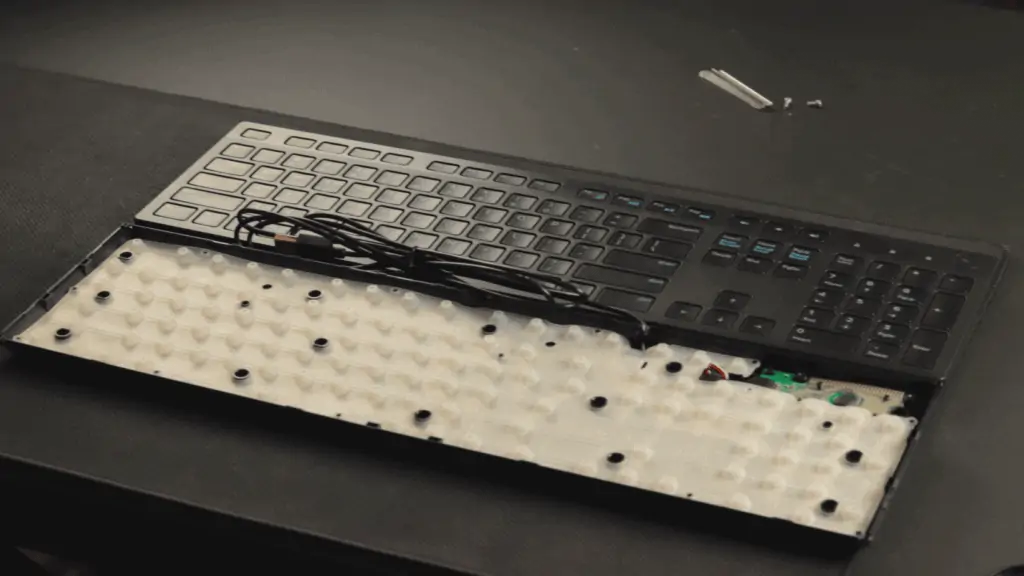When it comes to choosing a keyboard, there are two main types that dominate the market: membrane keyboards and mechanical keyboards. While both serve the same purpose of allowing us to input data into our computers, they differ in terms of their construction, feel, and performance. In this article, we will explore the differences between membrane keyboards and mechanical keyboards, and discuss which one might be better for gaming. We will also delve into the possibility of making a membrane keyboard feel more like a mechanical one.
Let’s start by looking at the construction of these two types of keyboards. A membrane keyboard is made up of a thin, flexible sheet that contains a series of rubber domes. When a key is pressed, the rubber dome beneath it collapses, completing an electrical circuit and registering the keystroke. This design makes membrane keyboards relatively quiet and lightweight, but it also means that they lack the tactile feedback and durability of mechanical keyboards.
On the other hand, mechanical keyboards are built with individual mechanical switches under each key. These switches are typically made of metal springs and contacts, which provide a satisfying click or tactile bump when pressed. The mechanical switches are known for their durability and responsiveness, making them a popular choice among gamers and typists who value precision and speed. However, mechanical keyboards tend to be heavier and louder compared to membrane keyboards.
When it comes to gaming, the choice between a membrane keyboard and a mechanical keyboard can have a significant impact on performance. Mechanical keyboards are often preferred by gamers due to their faster response times and more reliable key presses. The tactile feedback provided by mechanical switches allows gamers to feel exactly when a key has been pressed, which can be crucial in fast-paced games where split-second decisions matter. Additionally, the durability of mechanical switches ensures that the keyboard can withstand intense gaming sessions without experiencing key ghosting or failure.
However, it is worth noting that membrane keyboards can still be suitable for gaming, especially for casual gamers or those on a budget. While they may not offer the same level of precision and durability as mechanical keyboards, membrane keyboards can still provide a satisfactory gaming experience. Some membrane keyboards even come with features like anti-ghosting technology and programmable keys, which can enhance gameplay to some extent.
For those who prefer the feel of a mechanical keyboard but are not ready to invest in one, there are ways to make a membrane keyboard feel more like a mechanical one. One option is to use keycap replacements that mimic the shape and texture of mechanical keycaps. These replacements can give a membrane keyboard a more tactile feel and make it easier to distinguish between keys. Another option is to use O-rings, which can be placed under the keycaps to dampen the sound and reduce the travel distance of the keys, simulating the shorter actuation point of mechanical switches.
In conclusion, the choice between a membrane keyboard and a mechanical keyboard ultimately depends on personal preference and specific needs. While mechanical keyboards are generally considered superior in terms of performance and durability, membrane keyboards can still be a viable option for those on a budget or who prefer a quieter typing experience. With the right modifications, a membrane keyboard can even provide a similar feel to a mechanical one. So, whether you’re a gamer, a writer, or a casual computer user, there is a keyboard out there that will suit your needs.

Membrane keyboards are the most common type of keyboard found in everyday use. They are typically thin and lightweight, making them portable and easy to use. The name “membrane” refers to the thin, flexible layer that covers the key switches beneath. This layer is made up of three main components: a top membrane layer, a bottom membrane layer, and a conductive trace layer in between.
When a key is pressed on a membrane keyboard, the top membrane layer makes contact with the bottom membrane layer, completing an electrical circuit. The conductive trace layer detects this electrical signal and sends it to the computer, which registers the keystroke. Membrane keyboards are known for their quiet operation and low-profile design.
One of the advantages of membrane keyboards is their durability. The flexible membrane layer is resistant to dust, dirt, and spills, making it ideal for use in various environments. This makes membrane keyboards a popular choice for industries such as healthcare, where cleanliness and hygiene are crucial.
Another advantage of membrane keyboards is their affordability. Compared to other types of keyboards, such as mechanical keyboards, membrane keyboards are generally more cost-effective. This makes them a popular choice for budget-conscious consumers or businesses.
However, it’s worth noting that membrane keyboards may not provide the same tactile feedback as mechanical keyboards. Mechanical keyboards use individual switches for each key, resulting in a more satisfying and responsive typing experience. Some users may prefer the clicky feel of mechanical keyboards, especially for tasks that require a lot of typing or gaming.
Despite this, membrane keyboards have their own advantages. Their low-profile design and quiet operation make them suitable for office environments, where noise can be a concern. Additionally, the lack of moving parts in membrane keyboards makes them less prone to mechanical failures, increasing their overall reliability.
In conclusion, membrane keyboards offer a practical and affordable solution for everyday use. Their durability, portability, and low-profile design make them a versatile choice for a wide range of applications. Whether you’re typing up a document, playing a game, or working in a busy office, a membrane keyboard can provide a reliable and comfortable typing experience.
Moreover, mechanical keyboards offer a range of customization options that make them highly sought after by enthusiasts and professionals alike. With a membrane keyboard, you are limited to the pre-determined key travel distance and actuation force set by the manufacturer. However, mechanical keyboards come in a variety of switch types, each with its own unique characteristics.
For example, Cherry MX switches are one of the most popular options and come in different variants, such as Cherry MX Red, Blue, Brown, and Black. Cherry MX Red switches are linear and require a light touch to actuate, making them ideal for gamers who need rapid key presses. On the other hand, Cherry MX Blue switches have a tactile bump and an audible click, providing a satisfying typing experience for writers and programmers.
In addition to the different switch types, mechanical keyboards can also be customized with different keycaps. Keycaps are the plastic covers that sit on top of the switches and determine the look and feel of the keyboard. They can be made from various materials such as ABS plastic, PBT plastic, or even metal. Some enthusiasts even go as far as getting custom keycaps made with unique designs or colors to personalize their keyboard.
Another advantage of mechanical keyboards is their ability to support advanced features such as N-key rollover and anti-ghosting. N-key rollover allows you to press multiple keys simultaneously and have them all register accurately, making it essential for gamers who need to perform complex key combinations. Anti-ghosting, on the other hand, prevents missed keystrokes when you press multiple keys at once, ensuring that every keystroke is registered.
Furthermore, mechanical keyboards are known for their durability. The individual mechanical switches are designed to withstand millions of keystrokes, making them more reliable and long-lasting compared to membrane keyboards. This durability is particularly important for professionals who spend hours typing every day, as it ensures that their keyboard will continue to perform consistently over time.
In conclusion, mechanical keyboards offer a range of advantages over membrane keyboards. From the satisfying tactile feedback and customizable switch options to the durability and advanced features, mechanical keyboards provide a superior typing experience. Whether you are a gamer, writer, or programmer, investing in a mechanical keyboard can greatly enhance your productivity and enjoyment.
When it comes to gaming, the choice between a membrane keyboard and a mechanical keyboard ultimately depends on personal preference. Both types of keyboards have their own advantages and disadvantages in a gaming context. Membrane keyboards are often more affordable and widely available, making them a popular choice for casual gamers. They also tend to be quieter, which can be beneficial when gaming in shared spaces. However, membrane keyboards may not provide the same level of tactile feedback and responsiveness as mechanical keyboards, which can be crucial for competitive gaming.
On the other hand, mechanical keyboards are favored by many gamers for their precise key actuation and satisfying clicky feel. The tactile feedback provided by mechanical switches can help gamers react faster and execute commands more accurately. Mechanical keyboards also offer customizable options, such as different switch types with varying levels of actuation force and feedback.
One popular type of mechanical switch is the Cherry MX switch, which comes in different variants such as Red, Blue, Brown, and Black. The Red switch is known for its smooth linear feel and low actuation force, making it ideal for rapid key presses. The Blue switch, on the other hand, provides a tactile bump and an audible click, giving gamers a satisfying feedback with each keystroke. The Brown switch offers a compromise between the Red and Blue switches, providing a tactile bump without the loud click. Finally, the Black switch is known for its high actuation force, making it suitable for gamers who prefer a heavier and more resistant feel.

In addition to the different switch types, mechanical keyboards also offer other features that can enhance the gaming experience. Some keyboards have customizable RGB lighting, allowing gamers to personalize their setup and create an immersive gaming atmosphere. Others have programmable macro keys, which can be assigned to complex commands or shortcuts, giving gamers an edge in competitive gameplay.
Ultimately, the choice between a membrane keyboard and a mechanical keyboard for gaming comes down to personal preference and budget. If you prioritize affordability and a quieter typing experience, a membrane keyboard may suffice. However, if you are a serious gamer looking for a more immersive and responsive gaming experience, a mechanical keyboard may be worth the investment. With its precise key actuation, satisfying feedback, and customizable options, a mechanical keyboard can elevate your gaming performance and make every keystroke count. One additional option to consider for making a membrane keyboard feel more like a mechanical one is to use a keyboard customization software. These software programs allow you to modify the behavior of your keyboard, including adjusting the key response and feedback. With the right settings, you can simulate the feel of a mechanical keyboard by increasing the actuation force required for each key press and adjusting the key release point. This can provide a more satisfying typing experience and make your membrane keyboard feel more responsive.
In addition to software customization, you can also explore the option of adding a keyboard wrist rest. Wrist rests are ergonomic accessories that provide support and comfort for your wrists while typing. They can help alleviate strain and fatigue, allowing you to type for longer periods without discomfort. While a wrist rest won’t directly affect the tactile feel of your keyboard, it can enhance your overall typing experience and make it more enjoyable.
Another factor to consider when trying to make a membrane keyboard feel more like a mechanical one is the sound. Mechanical keyboards are known for their distinct clicky or tactile sound, which some users find satisfying and enjoyable. If you’re looking to replicate this sound with your membrane keyboard, you can explore the option of adding sound dampening materials. These materials can be applied to the inside of your keyboard to reduce the noise produced by the key switches. While this won’t change the feel of the keyboard, it can enhance the overall typing experience by providing a more immersive and satisfying sound.
It’s important to keep in mind that while these options can help enhance the feel of a membrane keyboard, they will still have limitations compared to a true mechanical keyboard. The underlying technology and construction of a mechanical keyboard are specifically designed to provide a unique typing experience that can’t be fully replicated with a membrane keyboard. However, by exploring these options and finding the right combination that suits your preferences, you can still enjoy a more tactile and satisfying typing experience with your membrane keyboard.



